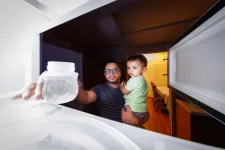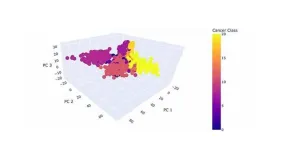(Press-News.org) The fastest way to heat food and drink might also rank as the fastest route to ingesting massive quantities of minuscule plastic particles, says new research from the University of Nebraska–Lincoln.
Experiments have shown that microwaving plastic baby food containers available on the shelves of U.S. stores can release huge numbers of plastic particles — in some cases, more than 2 billion nanoplastics and 4 million microplastics for every square centimeter of container.
Though the health effects of consuming micro- and nanoplastics remain unclear, the Nebraska team further found that three-quarters of cultured embryonic kidney cells had died after two days of being introduced to those same particles. A 2022 report from the World Health Organization recommended limiting exposure to such particles.
“It is really important to know how many micro- and nanoplastics we are taking in,” said Kazi Albab Hussain, the study’s lead author and a doctoral student in civil and environmental engineering at the University of Nebraska–Lincoln. “When we eat specific foods, we are generally informed or have an idea about their caloric content, sugar levels, other nutrients. I believe it’s equally important that we are aware of the number of plastic particles present in our food.
“Just as we understand the impact of calories and nutrients on our health, knowing the extent of plastic particle ingestion is crucial in understanding the potential harm they may cause. Many studies, including ours, are demonstrating that the toxicity of micro- and nanoplastics is highly linked to the level of exposure.”
The team embarked on its study in 2021, the same year that Hussain became a father. While prior research had investigated the release of plastic particles from baby bottles, the team realized that no studies had examined the sorts of plastic containers and pouches that Hussain found himself shopping for, and that millions of other parents regularly do, too.
Hussain and his colleagues decided to conduct experiments with two baby food containers made from polypropylene and a reusable pouch made of polyethylene, both plastics approved by the U.S. Food and Drug Administration. In one experiment, the researchers filled the containers with either deionized water or 3% acetic acid — the latter intended to simulate dairy products, fruits, vegetables and other relatively acidic consumables — then heated them at full power for three minutes in a 1,000-watt microwave. Afterward, they analyzed the liquids for evidence of micro- and nanoplastics: the micro being particles at least 1/1,000th of a millimeter in diameter, the nano any particles smaller.
The actual number of each particle released by the microwaving depended on multiple factors, including the plastic container and the liquid within it. But based on a model that factored in particle release, body weight, and per-capita ingestion of various food and drink, the team estimated that infants drinking products with microwaved water and toddlers consuming microwaved dairy products are taking in the greatest relative concentrations of plastic. Experiments designed to simulate the refrigeration and room-temperature storage of food or drink over a six-month span also suggested that both could lead to the release of micro- and nanoplastics.
“For my baby, I was unable to completely avoid the use of plastic,” Hussain said. “But I was able to avoid those (scenarios) which were causing more of the release of micro- and nanoplastics. People also deserve to know those, and they should choose wisely.”
With the help of Svetlana Romanova from the University of Nebraska Medical Center, the team then cultured and exposed embryonic kidney cells to the actual plastic particles released from the containers — a first, as far as Hussain can tell. Rather than introduce just the number of particles released by one container, the researchers instead exposed the cells to particle concentrations that infants and toddlers might accumulate over days or from multiple sources.
After two days, just 23% of kidney cells exposed to the highest concentrations had managed to survive — a much higher mortality rate than that observed in earlier studies of micro- and nanoplastic toxicity. The team suspects that kidney cells might be more susceptible to the particles than are other cell types examined in prior research. But those earlier studies also tended to examine the effects of larger polypropylene particles, some of them potentially too large to penetrate cells. If so, the Hussain-led study could prove especially sobering: Regardless of its experimental conditions, the Husker team found that polypropylene containers and polyethylene pouches generally release about 1,000 times more nanoplastics than microplastics.
The question of cell infiltration is just one among many that will require answers, Hussain said, before determining the true risks of consuming micro- and nanoplastics. But to the extent that they do pose a health threat — and that plastics remain a go-to for baby food storage — parents would have a vested interest in seeing that the companies manufacturing plastic containers seek out viable alternatives, he said.
“We need to find the polymers which release fewer (particles),” Hussain said. “Probably, researchers will be able to develop plastics that do not release any micro- or nanoplastics — or, if they do, the release would be negligible.
“I am hopeful that a day will come when these products display labels that read ‘microplastics-free’ or ‘nanoplastics-free.’”
The team reported its findings in the journal Environmental Science & Technology. Hussain and Romanova authored the study with the University of Nebraska–Lincoln’s Yusong Li, Mathias Schubert, Yongfeng Lu, Lucía Fernández-Ballester, Bing Wang, Xi Huang, Jesse Kuebler, Dong Zhang and Ilhami Okur. The researchers received support from the National Science Foundation and the Buffett Early Childhood Institute.
END
Billions of nanoplastics released when microwaving baby food containers
Exposure to plastic particles kills up to 75% of cultured kidney cells
2023-07-20
ELSE PRESS RELEASES FROM THIS DATE:
Researchers design multiclass cancer diagnostic tool using AI, MicroRNA
2023-07-20
Cancer is one of the most devastating diseases in the world. In 2023, more than 1.9 million new cancer cases and 609,820 deaths are projected to occur in the United States alone. As efforts are underway to improve diagnostic tools, microRNAs are at the forefront biomedical research.
MicroRNAs, or miRNAs, are a class of small non-coding ribonucleic acids (RNAs), which are essential for all biological functions. The main role of miRNA in the human body is gene regulation. As such, they regulate a variety of biological and pathological processes, including the formation and development of cancer. In fact, many cancers are closely associated with ...
Majority of older adults with cognitive impairment still drive
2023-07-20
The majority of older adults with cognitive impairment are still driving, despite concerns raised by caregivers and others, a Michigan Medicine study in a South Texas community finds.
Researchers assessed more than 600 adults over 65 years old in Nueces County, Texas, who had cognitive assessment scores that indicated a likelihood of impairment.
Of those people with cognitive impairment, 61.4% were current drivers, and around one-third of all caregivers had concerns about their care-recipient driving. The results are published in the Journal of the American Geriatrics Society.
“It is likely appropriate that some with mild cognitive impairment are ...
Study finds European breeding birds respond only slowly to recent climate change
2023-07-20
-With pictures-
Over the last 30 years European breeding birds have shifted their range by, on average, 2.4km per year, according to new research.
However, these changes were significantly different from expectations based on changing climate and landcover during that period.
Based on climate alone, the researchers predicted that the average range shifts by species should have been around 50% faster.
The study led by experts from Durham University, UK, used survey data collected as part of two Europe-wide ...
Researchers aim for rapid biomarker diagnostic test for stroke, using saliva
2023-07-20
Birmingham researchers are to set to collaborate on a study that could result in a rapid non-invasive diagnostic test to quickly and accurately identify stroke patients who need time-critical treatment before irreversible brain damage occurs.
Funded by the Stroke Association, the Golden HOur for STroke (GHoST) study will involve the West Midlands Ambulance Service University NHS Foundation Trust, Midlands Air Ambulance Charity, and University Hospitals Birmingham NHS Trust and industry partner Marker Diagnostics. A successful outcome could also revolutionise ...
Give more people with learning disabilities the chance to work, Cambridge historian argues
2023-07-20
Employment levels for people with learning disabilities in the UK are 5 to 10 times lower than they were a hundred years ago. And the experiences of workers from the 1910s–50s offer inspiration as well as lessons about safeguarding.
A new study by Cambridge historian Professor Lucy Delap (Murray Edwards College) argues that loud voices in the 20th-century eugenics movement have hidden a much bigger picture of inclusion in British workplaces that puts today’s low rates to shame.
Professor Delap found that in some parts of Britain, up to 70% of people variously labelled ‘defective’, ...
Use of law enforcement strategies to curb underage drinking has decreased over past decade: Study
2023-07-20
By Kimberly Flynn
PISCATAWAY, NJ — Despite the harm that excessive alcohol consumption can cause in a community, use of some alcohol-related enforcement strategies remained low or decreased from 2010 to 2019, according to a new report in the Journal of Studies on Alcohol and Drugs. In particular, researchers found a drop in enforcement of underage drinking laws.
Researchers at the University of Minnesota first surveyed 1,028 county and municipal law enforcement agencies throughout the United States in 2010 about their practices regarding three factors to alcohol harms in communities: underage drinking, impaired ...
The malnutrition paradox: Adolescent obesity in Zimbabwe
2023-07-20
In some African countries that have traditionally faced issues such as undernourishment and hunger, being overweight is perceived as a good sign of health and prosperity. However, in most of these countries, a malnutrition paradox is evident. Obesity, a chronic disease that affects millions of people worldwide, is increasing at an alarming rate in countries like Zimbabwe, where the consumption of processed, energy-dense foods associated with western lifestyles, has been adopted.
An insightful study led by graduate student Ashleigh Pencil, from the Graduate School of Human Life ...
Dreaming in technicolor
2023-07-20
A team of computer scientists and designers based out of the University of Waterloo have developed a tool to help people use colour better in graphic design.
The tool, De-Stijl, uses powerful machine learning technology to suggest intuitive colour palettes for novice designers and inexperienced users. The software combines and improves on the functionalities of existing tools like Figma, Pixlr, and Coolor, allowing users to select important theme colors and quickly visualize how they’ll impact a design.
“You put your graphical ...
NIH renews UC Davis MIND Institute grant to study fragile X-associated syndromes for 24th year
2023-07-20
It’s been 22 years since UC Davis MIND Institute Medical Director Randi Hagerman and her husband, researcher Paul Hagerman, discovered the neurodegenerative condition called FXTAS (fragile X-associated tremor ataxia syndrome). Hagerman, a pediatrician known for her enthusiasm for her work and patients, has been studying FXTAS ever since, seeking to develop treatments for it.
She was recently awarded her 24th consecutive year of funding from the National Institutes of Health for her fragile X-related work, a ...
AI must not worsen health inequalities for ethnic minority populations
2023-07-20
Scientists are urging caution before artificial intelligence (AI) models such as ChatGPT are used in healthcare for ethnic minority populations. Writing in the Journal of the Royal Society of Medicine, epidemiologists at the University of Leicester and University of Cambridge say that existing inequalities for ethnic minorities may become more entrenched due to systemic biases in the data used by healthcare AI tools.
AI models need to be ‘trained’ using data scraped from different sources such as healthcare websites and scientific research. However, evidence shows ...
LAST 30 PRESS RELEASES:
Post-stroke injection protects the brain in preclinical study
Cardiovascular risk score predicts multiple eye diseases
Health: estimated one in ten British adults used or interested in GLP-1 medications for weight loss
Exercise to treat depression yields similar results to therapy
Whooping cough vaccination for pregnant women strengthens babies’ immune system
Dramatic decline in new cases of orphanhood in Uganda driven by HIV treatment and prevention programs
Stopping weight loss drugs linked to weight regain and reversal of heart health markers
Higher intake of food preservatives linked to increased cancer risk
Mass General Brigham–developed cholera vaccine completes phase 1 trial
First experimental validation of a “150-year-old chemical common sense” direct visualization of the molecular structural changes in the ultrafast anthracene [4+4] photocycloaddition reaction
Lack of support for people on weight loss drugs leaves them vulnerable to nutritional deficiencies, say experts
Dogs’ dinners can have greater climate impact than owners’
Are you ready to swap salmon for sprats and sardines?
1.6 million UK adults used weight loss drugs in past year
American College of Cardiology comments on new dietary guidelines for Americans
American Society of Gene & Cell Therapy and Orphan Therapeutics Accelerator partner to advance and commercialize promising rare disease treatments
One in 14 patients having day case surgery have new or worse chronic pain 3 months after their operation
New study highlights link between eviction rates and gun violence
Heatwaves heat up soil but not toxin levels in rice, study finds
Digital modeling reveals where construction carbon emissions really come from
Turning farm waste into water filters
New study shows how the spleen helps the immune system accept a transplant
New Mayo Clinic study advances personalized prostate cancer education with an EHR-integrated AI agent
Researchers identify novel therapeutic target to improve recovery after nerve injury
Microbes in breast milk help populate infant gut microbiomes
Reprogramming immunity to rewrite the story of Type 1 diabetes
New tool narrows the search for ideal material structures
Artificial saliva containing sugarcane protein helps protect the teeth of patients with head and neck cancer
Understanding the role of linear ubiquitination in T-tubule biogenesis
Researchers identify urban atmosphere as primary reservoir of microplastics
[Press-News.org] Billions of nanoplastics released when microwaving baby food containersExposure to plastic particles kills up to 75% of cultured kidney cells




